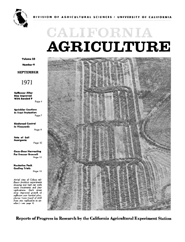All Issues

Cover:
Aerial view of Colusa safflower fertilizer experiment showing test laid out with seven treatments and four replications. Dark areas show improved growth of safflower over banded phosphorus (note travel of drill from one replication to another).
September 1971
Volume 25, Number 9
Volume 25, Number 9





